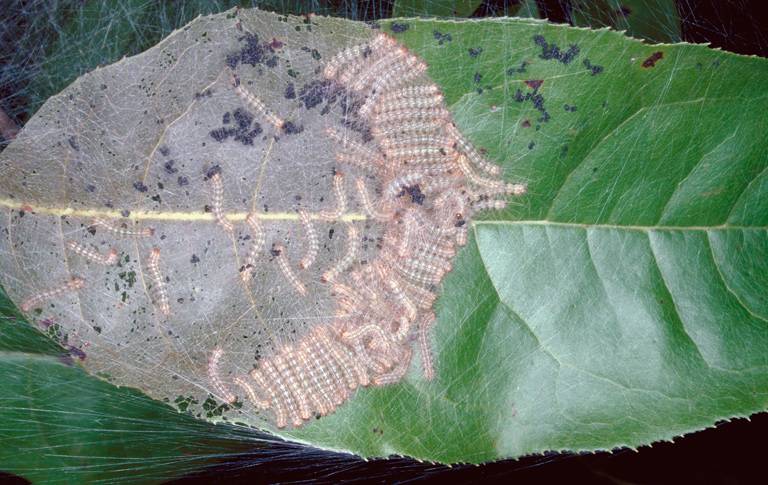Integrated Pest Management
Fall Webworm
 Adult fall webworm laying eggs on the underside of a leaf. (Lacy Hyche, Auburn University, Bugwood.org)
Adult fall webworm laying eggs on the underside of a leaf. (Lacy Hyche, Auburn University, Bugwood.org)
 Fall webworm larvae feeding on a leaf. (Lacy Hyche, Auburn University, Bugwood.org)
Fall webworm larvae feeding on a leaf. (Lacy Hyche, Auburn University, Bugwood.org)
 Fall webworm larvae feeding inside of a silken “tent.” (Lacy Hyche, Auburn University, Bugwood.org)
Fall webworm larvae feeding inside of a silken “tent.” (Lacy Hyche, Auburn University, Bugwood.org)
HOSTS
- Cottonwood
- Chokecherry
- Other ornamental trees
DESCRIPTION
The fall webworm, Hyphantria cunea, is a common defoliator of ornamental and fruit trees in Utah. Starting around late July, the caterpillars, webbing, and damage become noticeable, particularly in some of the canyons adjacent to populated areas.
BIOLOGY
Adult moths emerge from June to July, mate, and lay eggs on the under sides of host leaves (Fig. 1). Eggs hatch in about 1 to 2 weeks; larvae mature in about 6 weeks and drop to the ground to pupate. Pupation sites frequently occur in the soil, leaf litter, or under loose bark. Moths overwinter as pupae. There are one to two generations per year depending on location.
SYMPTOMS
- Web “tents” around larvae and leaves
- Defoliation late in the season
GENERAL MANAGEMENT
If webworms or their tents are located within a safe reaching distance by hand or pole, they can be physically removed or pruned out of the tree. A strong spray from a high-pressure hose can also dislodge tents.
INSECTICIDES
Chemical control of fall webworms is usually not recommended. On occasion, high numbers of caterpillars may be unsightly and become a nuisance pest that warrants control. When applying pesticides focus on the foliage surrounding the current tents or caterpillars to stop their expansion.
The microbial insecticide B.t. provides good control of fall webworms with minimal impact on other insects or wildlife. Dipel and Bonide are two products that contain B.t. For best results apply B.t. when newly hatched caterpillars first appear.

